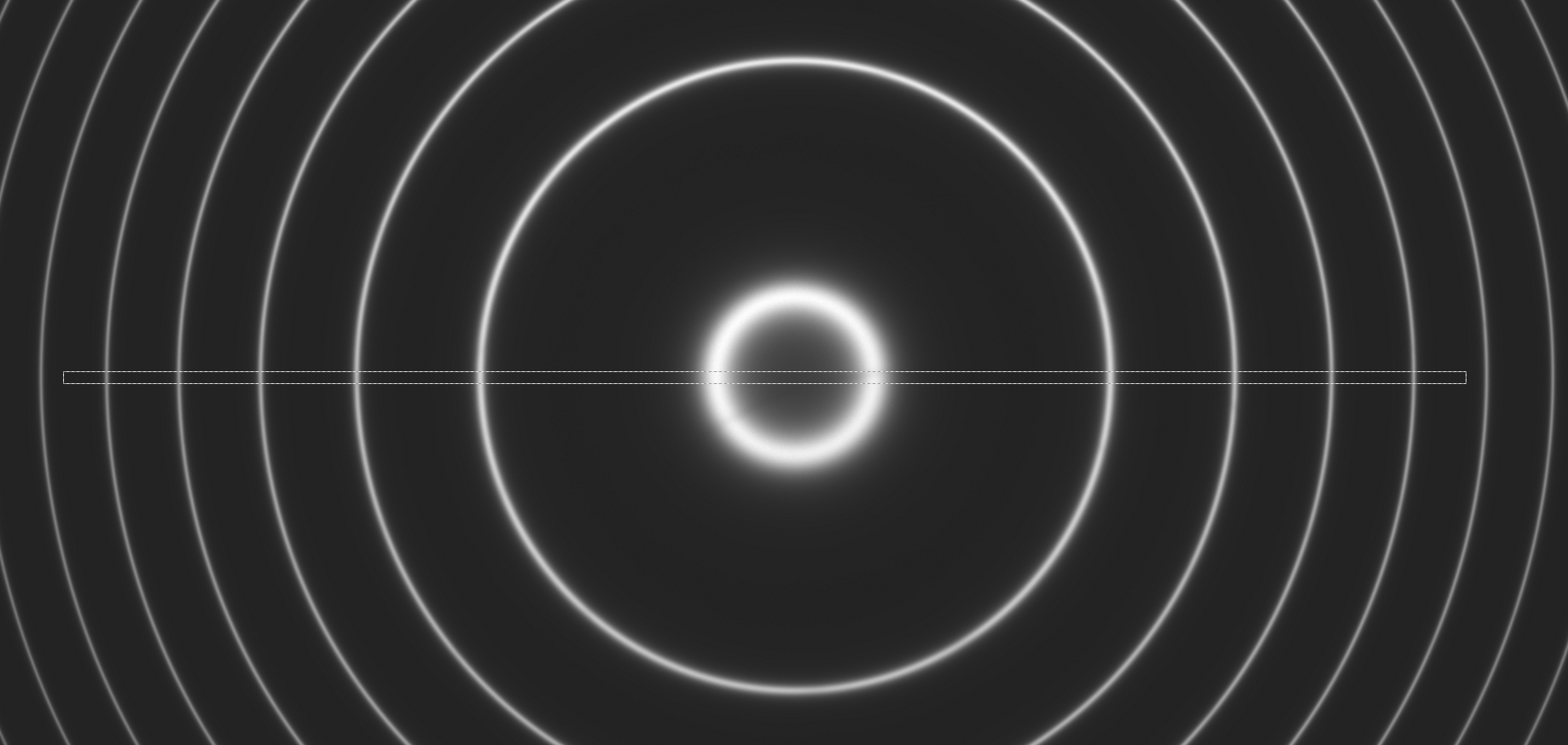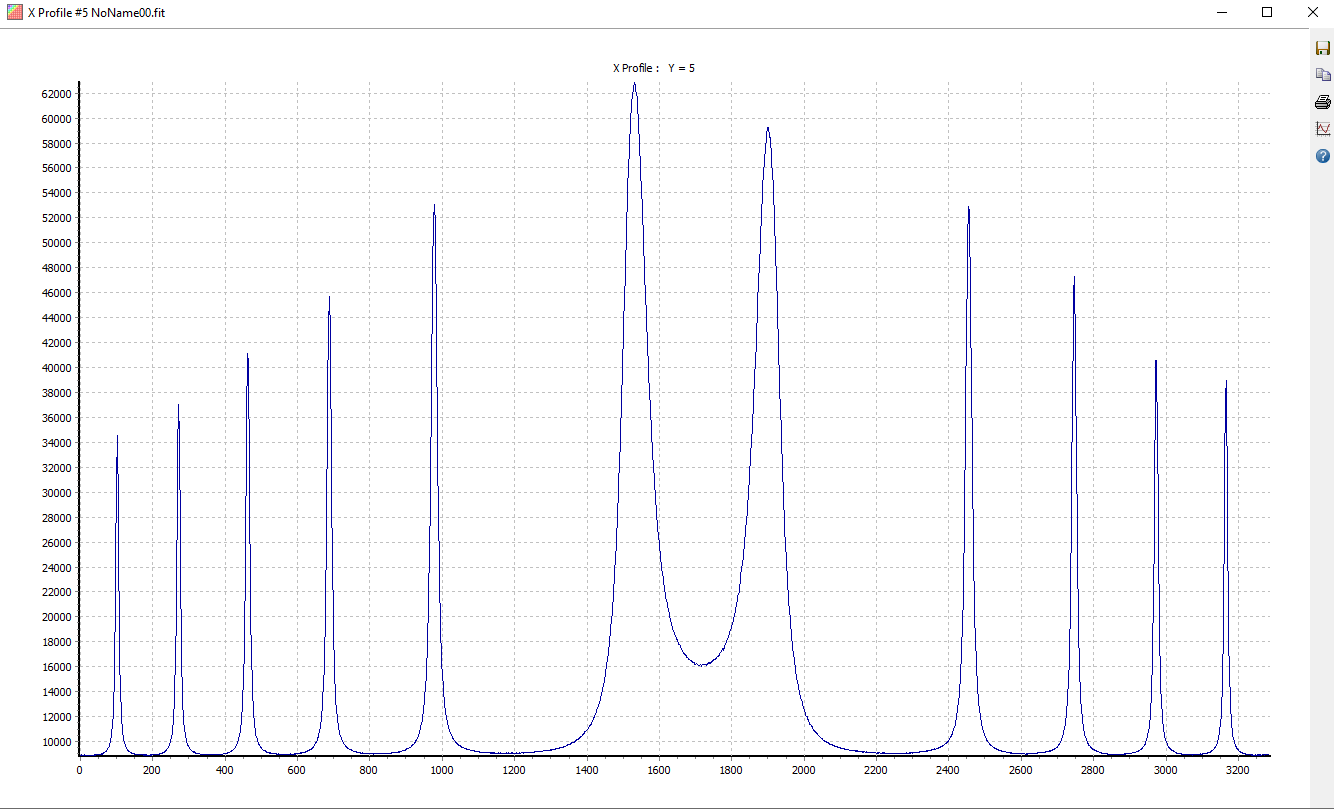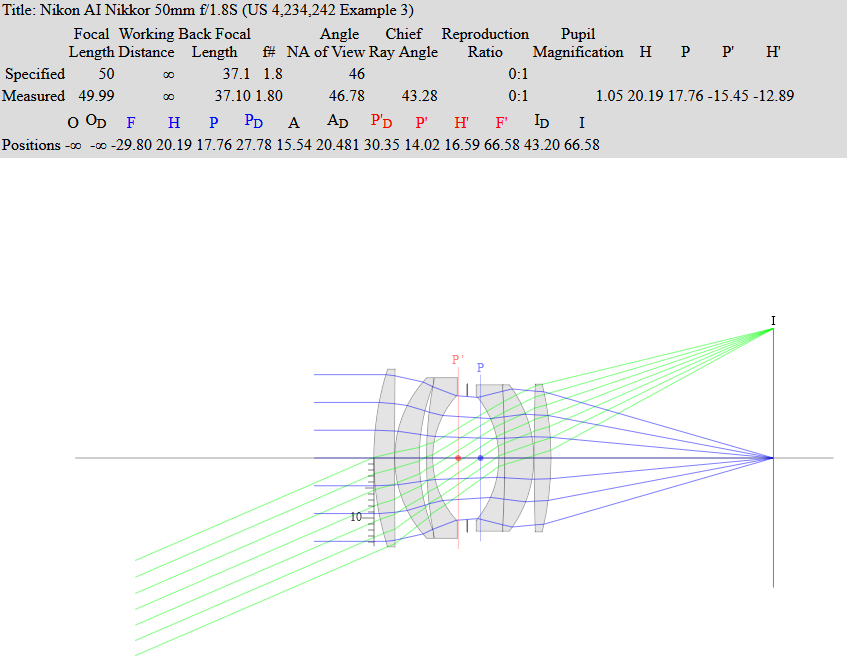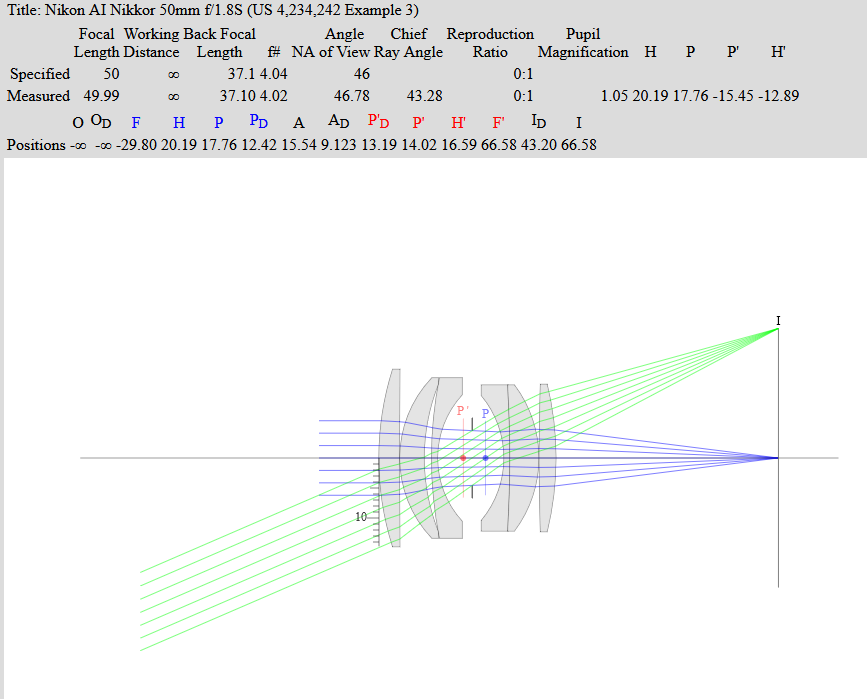Part 2 : Implementation and details of the measurement procedure
1) Acquisition tips
- Focus accuracy is critical. The camera lens is set to infinity ( manual focus) using viewfinder magnifier.
- To reduce vibration, the camera should be mounted on a tripod and no stabilization should to be used.
- The camera is released with a remote control.
- Manual exposure time. Autobracketing from -5 EV to +5 EV at 1 EV intervals is very useful.
- The measurement procedure involves measuring the FWHM of the fringes with the lens set at full aperture. Therefore, the lens should be of excellent quality even at full aperture. Otherwise the FHWM will be overestimated.
- Furthemore, the focal length of the lens should be measured with some accuracy. This is easily done with Astrometry.net. For example, the focal lengths of the Nikkor 85 mm f/1.8 S and the Nikkor 50 mm f/1.8 were respectly measured at 82.9 mm and 51.9 mm.
- 14-bit RAW acquisition (no distorsion correction or diffraction correction applied).
- A low ISO number is used to maximize S/N (no noise reduction applied).
- The hydrogen discharge lamp has a rather short service life. Outgassing in the vacuum tube occurs from the electrodes. The tube progressively becomes progressively whitish due to additional emission lines. Outgassing does not occur when the tube is cold. It is therefore recommended to run the tube for a maximum of 30 seconds and allow it to cool before starting a new cycle.
- Focus accuracy is critical. The camera lens is set to infinity ( manual focus) using viewfinder magnifier.
- To reduce vibration, the camera should be mounted on a tripod and no stabilization should to be used.
- The camera is released with a remote control.
- Manual exposure time. Autobracketing from -5 EV to +5 EV at 1 EV intervals is very useful.
- The measurement procedure involves measuring the FWHM of the fringes with the lens set at full aperture. Therefore, the lens should be of excellent quality even at full aperture. Otherwise the FHWM will be overestimated.
- Furthemore, the focal length of the lens should be measured with some accuracy. This is easily done with Astrometry.net. For example, the focal lengths of the Nikkor 85 mm f/1.8 S and the Nikkor 50 mm f/1.8 were respectly measured at 82.9 mm and 51.9 mm.
- 14-bit RAW acquisition (no distorsion correction or diffraction correction applied).
- A low ISO number is used to maximize S/N (no noise reduction applied).
- The hydrogen discharge lamp has a rather short service life. Outgassing in the vacuum tube occurs from the electrodes. The tube progressively becomes progressively whitish due to additional emission lines. Outgassing does not occur when the tube is cold. It is therefore recommended to run the tube for a maximum of 30 seconds and allow it to cool before starting a new cycle.
2) Measurement procedure
- If the 14-bit RAW files can't be read directly by the processing software, they can be converted to 16-bit files using Adobe DNG converter.
- The profile of the fringes in red channel is analysed along the horizontal diameter (X axis).
- If the S/N of the image is good, the profile can be taken as it is, or if the S/N is low :
- A 20-pixel high slice is cropped from the image.
- In this cropped image, the curvature of the fringes is negligeable, allowing to average the columns (Y axis) in order to increase the S/N.
- For example :
Coronado SM III 60 mm (tilt) - Nikon Z6 with 85 mm S f/1.8 lens at f/1.8 - 100 ISO - 1/2s - 14 bit acquisition - RAW mode - Red channel.
Cropping
a slice of fringes along the horizontal diameter of the etalon.
Note the central dip due to the CWL (red) offset at normal
incidence.
- The X profil of the cropped image is extracted.
SM III 60 mm (tilt) - Nikon 85 mm f/1.8 S at f/1.8 - 100 ISO - 1/2s.
X profile along the 12 fringes central fringes.
X profile along the 12 fringes central fringes.
The profile and position of each fringe is measured with Fityk :
- If the etalon is reasonably good, the fringe profile should be a Lorenztian function.
- If the etalon is not uniform etalon an/or specially bad, the fringe profile may be a Voigt function, or even worse a non symetrical Lorentzian or Voigt function.
- Accordingly, each fringe is least-squares fitted to a Lorentzian + linear function. The linear function is intended to model the background light (if any). If there is no background light, including a constant in the fit function is enough.
- The FWHM and the center of the Lorentzian function are estimated by Fityk.
- The CWL offset of the etalon is calculated based on the radius of the central ring (if any) : delta CWL = i^2 / n^2, where delta CWL is in A, i is in degrees, n is the index of the gap (1 for air, about 1.6 for mica)..
- The FWHM and center of the other fringes are used to calculate the FSR and FWHM according to the formulas presented in part 1.
Fitting
a Lorentzian + constant function to fringe #1 Fityk. The
FWHM (9.2 pixel) and center (X= 73.6 pixel) of the Lorentzian is
extracted.
3) Calculation spread sheet
The following extract gives an example of calculation according to the formulas provided in the theoritical part.
(1) On the left side, calculation of the FSR:
- red color in yellow cells: measurements of FWHM and position of 6 fringes (left) and 5 fringes (right)
- calculation of fringe centers: used for checking
- for each fringe: radius of the fringe = 1/2 diameter
- for each fringe, calculation of the radius of the fringe i in radian (conversion pixel -> micron -> radian)
- for each fringe, calculation of cos^2 (i) (see explanations in the pdf)
- for each couple of sucessive fringes n, n+1, calculation of cos^2 (i) fringe (n+1) - cos^2(i) fringe (n) => this value is a constant (if measurements are accurate) => take average value over 3 couple of fringes => result is used to calculate the FSR in Angstrom : 8.5 A.
On the right side, calculation of finesse and FWHM:
- for each fringe, calculation of the average value of the FWHM of the fringe in pixel (left/ right), conversion in radian,
- for each fringe, calculation of angles i+k, i-k (see explanations in the pdf).
- for each fringe, calculation of FWHMA in radian^2,
- for each fringe, calculation of delta cos^2 (see explanations in the pdf) => this value is a constant => take average value over 4 fringes => result is used to calculate the finesse (=17.55), and FWHM = FSR/ Finesse.

Link to an example of spreadsheet.
Consistency checks and first look at etalon non-uniformity:
- A difference between FWHM L and FWHM R could be an indication of etalon non-uniformity wrong setup (poor lens quality).
- The column "calculated center" should show about the same value, otherwise there is something wrong with the measurements.
- The first column "delta cos 2" (0.00260, etc.) should give fairly similar results, otherwise something is wrong with the measurements.
- The second column "delta cos 2" (0.0000146, 0.0000148, etc.) is very sensitive to the accuracy of focus and optical quality of the lens. If some data do not seem accurate enough, they could be excluded from the calculation of the average FWHMA.
Consistency checks and first look at etalon non-uniformity:
- A difference between FWHM L and FWHM R could be an indication of etalon non-uniformity wrong setup (poor lens quality).
- The column "calculated center" should show about the same value, otherwise there is something wrong with the measurements.
- The first column "delta cos 2" (0.00260, etc.) should give fairly similar results, otherwise something is wrong with the measurements.
- The second column "delta cos 2" (0.0000146, 0.0000148, etc.) is very sensitive to the accuracy of focus and optical quality of the lens. If some data do not seem accurate enough, they could be excluded from the calculation of the average FWHMA.
4) Correction to be applied to account for the FWHM of the hydrogen lamp
This method uses a hydrogen lamp as a light source. The measured FWHM is actually the convolution of the FWHM of the etalon and the FWHM of the hydrogen lamp.
(FWHM measured)2 =(FWHM etalon)2 + (FWHM lamp)2
Given that the FWHM of the lamp was measured to be 0.263 A (see more info here), the relation between the measured FWHM and the actuel FWHM is :
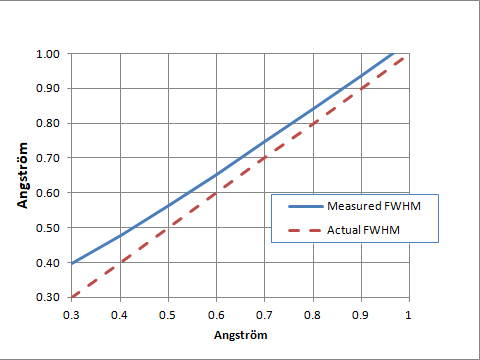
5) Area of the etalon sampled
The area sampled (i.e. measured) on the etalon is determined by the diameter of the aperture stop of the
camera lens (and also by vignetting due to the
etalon barrel and lens combination). For example, an 85 mm f/1.8 lens samples an area
of (approximately) 46.1 mm in diameter on the etalon, while the same lens at f/8 samples an area less than 10.6 mm.
- An easy way to understand this is as follows :
- The fringe system is at the infinite.
- The size of each fringe on the camera sensor depends on its angular diameter and on the focal length of the lens (just like the size of any celestial object).
- The light beam coming from any point of a given fringe is a collimated beam intercepting the whole surface of the etalon (except vigneting due to the etalon barrel).
- Accordingly, the size of the area sampled on the etalon is determined by the size of the aperture stop of the camera lens (to an approximation, see bottom of the page).
- In a perfect world, and in order to sample the entire surface of the etalon in a single shot and estimate the average FWHM and FSR over the full aperture of the etalon, we should use a lens whose aperture is similar to the aperture of the etalon. This is an issue because usually lens have a poorer optical quality at full aperture.
- Otherwise, measurements made with a lens with a small aperture should be properly integrated over the whole aperture of the etalon to estimate the FWHM at full aperture..
- The farther the camera (or the eye) from the etalon the lower the number of fringes is seen (the angular diameter of the fringes is unchanged, while the angular diameter of the etalon and central spacer decreases). This does not change thes size of the area sampled on the etalon.
- An easy way to understand this is as follows :
- The fringe system is at the infinite.
- The size of each fringe on the camera sensor depends on its angular diameter and on the focal length of the lens (just like the size of any celestial object).
- The light beam coming from any point of a given fringe is a collimated beam intercepting the whole surface of the etalon (except vigneting due to the etalon barrel).
- Accordingly, the size of the area sampled on the etalon is determined by the size of the aperture stop of the camera lens (to an approximation, see bottom of the page).
- In a perfect world, and in order to sample the entire surface of the etalon in a single shot and estimate the average FWHM and FSR over the full aperture of the etalon, we should use a lens whose aperture is similar to the aperture of the etalon. This is an issue because usually lens have a poorer optical quality at full aperture.
- Otherwise, measurements made with a lens with a small aperture should be properly integrated over the whole aperture of the etalon to estimate the FWHM at full aperture..
- The farther the camera (or the eye) from the etalon the lower the number of fringes is seen (the angular diameter of the fringes is unchanged, while the angular diameter of the etalon and central spacer decreases). This does not change thes size of the area sampled on the etalon.
6) Local or full-aperture FWHM: what is the most relevant?
The FWHM and CWL of an etalon may vary locally depending on the area sampled on the etalon.
(a) When the etalon is placed in front of the aperture of the telescope:
- All parts of the etalon contribute equally to the quality (i.e. contrast) of the image. Accordingly, the relevant value to qualify the etalon performance is the FWHM (and CWL) integrated over the full aperture of the etalon, and not the local values of FWHM and CWL.
- However, the mapping of the local values of FWHM and CWL can still be used to calculate the average (or integrated) values over the full aperture of the etalon. The integration of the FWHM acrossf the full aperture of the etalon is correct only if it takes into account both the local values of FWHM and CWL.
- For example, let's consider an etalon whose local values of FWHM are all 0.3 A, but whose CWL changes dramatically of +/1 A from one area sampled to the other. If we calculate the average FWHM over the full aperture of the etalon only from the local FWHM value statistics, then the result (0.3 A) is wrong, because of the strong variation of CWL over the aperture. In fact, a correct calculation should include both FWHM and CWL statistics.
(b) For an etalon placed in the rear position:
- Let's assume an observation of the Sun with a 2 m focal length telescope. The diameter of the solar disk at the focal plane is about 2 cm.
- All the area of the etalon within this central 2 cm diameter contribute equally to the contrast of the image.
- Accordingly, the relevant value for the observation is again the average (or integrated) values of FWHM and CWL, and not the local values.
7) Accuracy of the measurement
The accuracy of measurement on :
- The quality of the lens used. The FWHM of the lens can be measured over the field of view and at various f-numbers using CCD inpector. See various examples here.
- The accuracy of the focal length of the lens. The focal length can be measured using Astrometry.net
- The accuracy of the focusing.
- The good sampling of the fringe profile in order to get a good estimate for the curve fitting. To be on the safe side, the FWHM of the fringe should be greater than 10 pixels.
Measuring air-spaced etalons is much easier than measuring mica-spaced etalons because:
- transmission is much higher (>60%) versus a few percent, which means better S/N in fringe profiles because lower ISO can be used,
- smaller FSR (typically 10-12 A versus 20-30 A for mica-spaced etalons) and refractive index (1 instead of about 1.6), meaning a larger number of fringes can be measured (more than 5 versus 2 or 3 at most for mica-spaced etalons),
- the 2nd and 3rd interference fringes of mica-spaced etalons are very faint, so it is necessary to surexpose massively to detect them,
- for some reason (polarizers not properly aligned ?), it happends that the fringes of mica-spaced etalons tends to be less symetrical than the fringes of air-spaced etalons.
8) Additional note on the size of area actually sampled on the etalon due to camera lens vigneting effect:
These ray-tracing for Nikon 50 mm f/1.8 are from : https://www.photonstophotos.net
Nikon 50 mm f/1.8 at f/4 - The entrance pupil (Pd in blue) is 12.42 mm.
